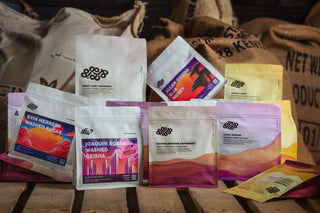Welcome to #customroasterseries, about our 45kg coffee roaster that we finished designing and building this past summer (after 3 years of work!). First, your burning question: “why the heck would you build your own roasting machine, aren’t there great machines that you can just buy new”? This is a very important question, and one that we grappled with for some time before considering a custom option. There are great new machines from Giesen, Probat, Joper, and Loring, etc. and we considered all of them. Ultimately, what I concluded is two things:
- Every new roaster I looked at had things I didn’t like about it.
- To address these issues would be difficult because I’d be modifying a proprietary system. In the end, it just seemed to make more sense to start from the body of an old roaster and build up from there.
To start the series, let’s talk about the coffee cooling process. In the 1st photo (the title shot) coffee is exiting the roasting drum. The coffee is still actually roasting at this point, until it reaches a sufficiently low temperature. I thought a lot about how to better control the cooling process on our new machine, as it’s so integral to the final roast level. As a 1st step, I installed an infrared probe (IR) on the cooling tray-see below:

This gathers real-time data on the surface temperature of the coffee as it cools, which is saved with each roast profile.
The 3rd photo below shows a graph of the IR data after a digital lowpass filter (x-axis is seconds cooling, y-axis is °F):

The 2nd step I took was to implement software control of the cooling fan speed. To tie these two parameters together, we use an analysis of the IR data to select the fan speed for each coffee and each batch size. This speed is then programmed so it automatically changes in our software when the coffee and batch size are selected. This auto-selection ensures that the correct cooling profile is always used! In the future, I plan to implement a more real-time loop between the IR temperature reading and the fan speed. For now, this has been a great step to massively improving our cooling consistency and control. Stay tuned for the next #customroasterseries!
-Phil
Photos courtesy of Marnie Burkhart, Jazhart Studios.







